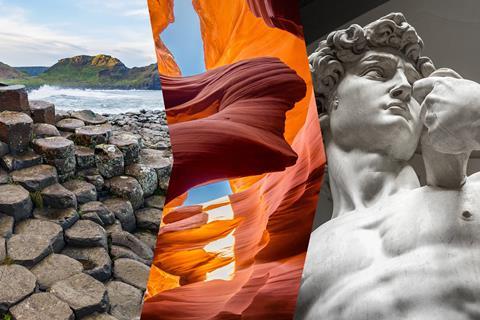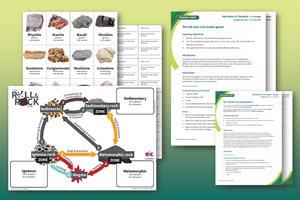Develop your practice with this ultimate guide to teaching the chemistry of the rock cycle

In 1990, while walking along the beach in West Runton, North Norfolk, local residents Margaret and Harold Hems discovered what looked like a giant bone sticking out from the cliff face. Following a further discovery of three more large bones, a three-month excavation unearthed 85% of a mammoth skeleton. Studies revealed the skeleton to belong to a male mammoth who is believed to have died at about the age of 42 while walking in a fresh-water river bed 700,000 years ago.
Many students at a young age have a fascination with dinosaurs and all things prehistoric. For most, this will have been sparked by a visit to a museum and an exhibit with, at its centre, a mounted dinosaur skeleton. Tap into this childhood fascination to engage students with fossils, sedimentary rocks and the wider rock cycle.
What students need to know
- Rocks can be classified into one of three types: igneous, metamorphic and sedimentary.
- The Earth’s rocks do not stay the same forever. They are continually changing as a result of chemical and physical processes.
Ideas for the classroom
Use models to support student understanding of the changes involved in the rock cycle
The rock cycle explains the series of changes that rocks go through under the influence of weathering, erosion, pressure and heat as they are slowly altered from one form to another. This activity from the Geological Society models these processes using chocolate. Chocolate can be ground into small particles (weathered), heated, cooled and compressed just like rocks – but at a lower temperature, making it suitable for classroom use. To maximise the learning from the activity, encourage students to evaluate the model by comparing it to the actual rock cycle.
The rock cycle explains the series of changes that rocks go through under the influence of weathering, erosion, pressure and heat as they are slowly altered from one form to another. The Chocolate rock cycle activity from the Geological Society models these processes (LINK). Chocolate can be ground into small particles (weathered), heated, cooled and compressed just like rocks – but at a lower temperature, making it suitable for classroom use. To maximise the learning from the activity, encourage students to evaluate the model by comparing it to the actual rock cycle.
Download this
A simple board game to help students avoid the common misconception that there is only one set path through the rock cycle from the Education in Chemistry website: LINK
Use practical work to help students develop their scientific reasoning
The classification of rocks provides an excellent opportunity for students to develop their scientific reasoning. After introducing students to the different rock types and their properties, ask them to classify samples of rock based on their appearance and simple physical properties. To deepen students’ understanding, students can use this virtual rock kit to identify links between rock type and particle arrangement.
Alternatively, ask students to identify specific rock samples. TeachIt Science’s Identifying rocks resource includes a simple key that students can follow in order to identify some common rocks.
The classification of rocks provides an excellent opportunity for students to develop their scientific reasoning. After introducing students to the different rock types and their properties, ask them to classify samples of rock based on their appearance and simple physical properties. To deepen students’ understanding, students can use the virtual rock kit from the Earth Science Education Unit to identify links between rock type and particle arrangement (LINK).
Alternatively, ask students to identify specific rock samples. TeachIt Science’s Identifying rocks resource includes a simple key that students can follow in order to identify some common rocks (LINK).
Make links to future careers to help students see the relevance of their learning

In August 1173, builders began work on the construction of the circular bell tower of the Cathedral of Santa Maria Assunta in Pisa, Italy. Almost immediately the tower began tilting, owing to the foundation stones being laid on soft ground consisting of clay, fine sand and shells. The lean continued to increase until 1993 when a team of civil engineers undertook work to straighten it by carefully removing soil from its non-leaning side. Although still far from straight, the Leaning Tower of Pisa, as it is commonly known, will now be stable for another 200 years.
Civil engineers design and manage construction projects, from bridges and buildings to transport links and sports stadiums. They must use their understanding of the rock cycle and the effect that a change in environment – including heat and pressure – might have on different rocks and soils to assess the impact and risk to humans associated with new buildings.
Link the curriculum learning to potential future careers to increase students’ science capital and help them to relate the science learned in the classroom to everyday life.
Common misconceptions
It is common for students to think of the world as being unchanged because of the timescales involved in the transformations discussed in this topic. To overcome this, when teaching the rock cycle give an indication of the timescales involved: the Earth is thought to be about 4600 million years old; the changes described in the rock cycle usually take thousands of years; average human life expectancy is about 80 years.
Many students believe there is only one set path through the rock cycle. The name ‘cycle’ itself doesn’t help, suggesting a sequence of changes which is often supported by simplified diagrams such as that on the left below.

Avoid these sorts of diagrams and instead opt for diagrams such as that on the right, which show all the processes that cause rocks to be interchanged between the different forms. Download and use the simple board game to help students avoid this common misconception.
Avoid these sorts of diagrams and instead opt for diagrams such as that below, which show all the processes that cause rocks to be interchanged between the different forms. Download and use the simple board game (below) to help students avoid this common misconception.
As teachers we may add to this misconception in the sequencing of our teaching by structuring lessons around rock types. A common sequence is a lesson on igneous rocks followed by one on sedimentary rocks and finally one on metamorphic rocks. To avoid this, consider focusing lessons around the key concepts of:
- making rocks by heating,
- physical weathering and erosion, and
- making rocks by pressure and cementing.
This is the sequence recommended in the Best Evidence Science Teaching (BEST) project subject map for chemistry and earth science.
This is the sequence recommended in the Best Evidence Science Teaching (BEST) project subject map for chemistry and earth science (LINK).
Formative assessment
Use well-designed multiple choice quizzes to provide a quick and easy way to assess students’ learning. Try the example in this Rock cycle interactive resource to quickly assess students’ knowledge and understanding at the end of the rock cycle topic. Based on gaps identified, students can revisit the learning using the other activities in the resource.
Use well-designed multiple-choice quizzes to provide a quick and easy way to assess students’ learning. Try the example in the Rock cycle interactive resource to quickly assess students’ knowledge and understanding at the end of the rock cycle topic (LINK). Based on gaps identified, students can revisit the learning using the other activities in the resource.
Progression to 14–16
The earth science curriculum at 14–16 focuses on the resources obtained from the Earth. This includes the extraction and purification of metals from ores, and the formation of crude oil and its use as a source of carbon compounds. There is an increasing demand for these limited resources the Earth provides. Students consider how chemists seek to operate sustainably and minimise the impact human activity has.
Take-home points
- Rocks are continually changing as a result of chemical and physical processes.
- The rock cycle proceeds in no particular order. For example, igneous rock can change into metamorphic or sedimentary rock over time, and metamorphic rock can become sedimentary or igneous.
- Students’ science capital can be increased by showing the relevance of the rock cycle for future careers.
- The grouping of rocks based on how they are formed provides just one example of the classification of objects and organisms. This is used widely across all science disciplines, making it easier to see similarities and differences.
More resources
- Display this rock cycle infographic poster to engage learners and brighten up your classroom.
- Take a closer look at volcanoes with this article and resource about eruptions.
- Use this lesson plan to challenge learners to construct their own rock cycle and become rock cycle experts.
- Download this lesson plan and find out what happens to weathered pieces of rock in your 11–14 classes.
- Inspire your learners to study geology at university and explain why they need chemistry to do so.
Catherine Smith is a secondary school teacher at Hinckley Academy and John Cleveland Sixth Form Centre















No comments yet